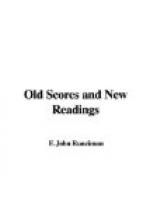human voice, while Verdi has always tried to make
the voice sound like an instrument. His roulades
and cadenzas, for example, sound prettier on the clarinet
than on the voice, as one hears when he sets the one
chasing the other in “Traviata”; and if
only our orchestral players would take the trouble
to play with the same expression as the stage artists
sing, we might soon be content to have a repetition
(with a difference) of the feat of the old-world conductor
who, in the absence of the hero, played the part upon
the harpsichord with universal applause. The
stock patterns out of which the songs are made soon
grow old-fashioned, and are superseded by fresh ones:
hence Verdi’s songs are the earliest portions
of his operas to wither. There are two powerful
scenes in “Aida”—the second
of the second act, and the final in the last act.
The last is certainly terribly repulsive at the first
blush; but the weird chant of the priestesses in the
brightly-lit temple, where the workmen are closing
the entrance to the vault underneath in which we see
Radames left to die, contrasts finely with the sweet
music that accompanies the declaration of Aida that
she has hidden there to die with him; and, while guessing
at the splendour of the music Wagner might have given
us here, one may still admit Verdi to have succeeded
well in a smaller way than Wagner’s. But
on the whole “Aida” is to be heard once
and have done with, for save these scenes there is
little else in it to engage one. Aida is alive,
but Amneris is a hopeless piece of machinery—something
between the stage conception of a princess and the
Lady with the Camellias, any difference in modesty
being certainly not in favour of Amneris. The
music very rarely rises above commonness—that
commonness which is proclaimed in every bar of Verdi’s
instrumentation, and in his shameless Salvation Army
rhythms; and it is sometimes (as in the Priest’s
solo with chorus in the last scene of the second act)
odiously vulgar. “Aida” is more dramatic
than “Traviata,” has more of Verdi’s
brusque energy, less of his sentimentality; but it
has none of the youthful freshness of his latest work.
The young Verdi has already aged—how long
will the old Verdi remain young?
“THE FLYING DUTCHMAN”
Wagner took “The Flying Dutchman”, “Tannhaeuser,”
and “Lohengrin,” in three long running
steps; from “Lohengrin” he made a flying
leap into the air, and, after spending some five or
six years up there, he landed safely on “The
Nibelung’s Ring.” The leap was a prodigious
one, and you may search history in vain for its like;
and still more astounding was it if you reckon from
the point where the run was commenced. “The
Flying Dutchman” was avowedly that point.
“Die Feen” is boyish folly, and “Rienzi”
an attempt to out-Meyer Meyerbeer. But in the
“Dutchman” Wagner sought seriously to realise
himself, to find the mode of best expressing the best
that was in him. That mode he found in “The
Rheingold” and mastered in “The Valkyrie,”
with its continuous development and transmogrification
of themes. And (to discard utterly my former
metaphor) after steeping oneself for several nights
in that last great river of melody, wide and deep and
clear, it is interesting to be led suddenly to its
source, and see it bubbling up with infinite energy,
a good deal of frothing, and some brown mud.




